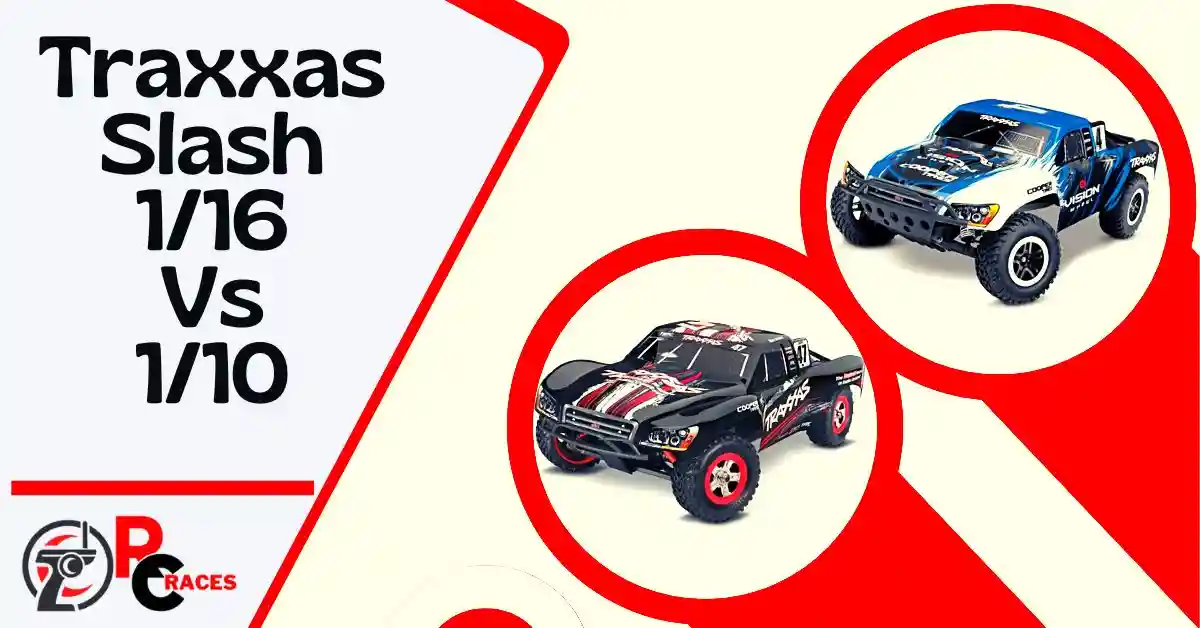Different scaling of Rc cars leaves many of us confused. Are they the same car but in different sizes?
So, are you stuck between traxxas slash 1/16 vs 1/10?
Traxxas Slash 1/10 is bigger and heavier than the Slash 1/16. The bigger size allows better-performing components, more upgradability, and a wider choice of batteries. The Slash 1/16 is more compact but handles better. It also has a longer runtime
This is just a gist of the differences between the two scale models. Go through our article to learn more about the two models
General Overview
You might think that the size is the only difference between a Traxxas Slash 1/16 and 1/10. But you will be wrong. There are many things that differ between the two models.
The differences between the two scale models are not as clear as the differences between two different models. Like the Slash vs Stampede.
So what are the differences you may ask? Well, we listed them below.
| Differences | Traxxas Slash 1/16 | Traxxas Slash 1/10 |
| Size | Smaller | Bigger |
| Weight | 1 kg | 2.16 kg |
| Top Speed | 30 mph | 60 mph |
| Control | Better | Good |
| Battery | 2S LiPo | 2S and 3S LiPo |
| Runtime | Upto 20 minutes | Upto 15 minutes |
| Upgradability | Less | More |
| Charging Adapter | Only DC charger | None |
| Price | Around $200 | Around $450 |
The table gives you an idea where the two scale models differ. But there are more nuances that go into the differences.
In-depth Comparison
We already mentioned that the size is not the only difference between the two Traxxas Slash models. So, you got a glance at the differences. Now, let us get into the details.
Size
Size is the most glaring difference between a Traxxas Slash 1/16 and 1/10. The 1/16 and 1/10 scale number represents the size of the RC compared to a real scale model. So what is bigger 1/10 or 1/16 scale?
Now don’t be fooled by the bigger number. The 1/16 is smaller than the 1/10. Yes, the Traxxas Slash 1/10 is bigger than the 1/16 is the smaller model.
Note that a ⅛ scale model is bigger than a 1/10 model.
Winner: This round is a draw. The preference for size will vary from person to person.
Weight
Weight is another clear point of difference along with the size of the models. The bigger model will be heavier.
The Slash 1/16 is around 1 kg while the 1/10 model is around 2.16 kg. So the bigger model is almost twice as heavy.
The weight matters in many aspects such as control, momentum, the center of gravity, etc. but these aspects depend on other metrics as well. So how they affect the performance will be discussed along with each aspect.
You’d expect the heavier model to be slower. But the bigger and heavier model is more powerful and faster. So weight does not alone affect performance drastically.
Winner: This round is also a draw. The effect of weight varies.
Top Speed
Now let us get into the not-so-obvious differences. The first one is top speed. Top speed is something almost every buyer looks into before getting a new RC.
You might think that the smaller and lighter model is faster. But the bigger model, the Slash 1/10, is the faster one.
Having a bigger chassis enables the Slash 1/10 to come with more powerful components. A bigger battery and more powerful motor let the 1/10 model hit up to 60 mph easily. Upgrades may further increase that top speed.
The Slash 1/16, on the other hand, only has a top speed of 30 mph. The smaller motor and battery limit the top speed.
Winner: The Traxxas Slash 1/10 wins this round because of its higher top speed.
Control
Now speed is not the only thing that matters while driving. Control is just as important as speed, in some cases even more important.
The smaller Slash 1/16 has better control than the 1/10 model. The lower top speed makes it easier to drive and handle.
The 1/16 is much lighter than the bigger model as well. That helps it make sharper turns and have a crispier control.
The chassis of the 1/16 also plays a part in its having better control. The chassis is lower than the bigger model. This offers a better center of gravity in terms of controlling the RC.
But do not think that the control of the Slash 1/10 is bad in any regard. The smaller model just has the upper hand.
Winner: Traxxas Slash 1/16 wins because of better handling.
Battery
Now just the batteries needed to power the two models are not different. The battery placement is also different.
The Traxxas Slash 1/16 has a dual battery loadout. It has two tray holders on both sides of the chassis for the battery and the model requires LiPo 2S batteries to drive.
On the other hand, the Traxxas Slash 1/10 holds the battery on the chassis. There are specific holders for the battery. The Slash 1/10 can run with both LiPo 2S and 3S batteries
Winner: The Traxxas Slash 1/10 wins because it can operate with a wider range of batteries.
Runtime
Something that directly correlates with the battery is the runtime of the RC. Having a longer runtime means having more fun in one go.
Now the runtime of the Slash 1/16 is around 20 minutes. This means you can go driving for up to 20 minutes with one recharge.
The lighter weight and lesser power of the smaller model make it more battery efficient. Giving it a longer runtime.
On the other hand, Traxxas Slash 1/10 has a runtime of up to 15 minutes. The heavier body and higher performing components draw more power from the battery. So even though this model has a bigger battery, it has a shorter runtime.
Winner: The Traxxas Slash 1/16 wins with the longer runtime.
Upgradability
Options of upgradability and customization make RCs more fun and unique to the driver. It also leaves room for future improvements.
The Smaller Traxxas Slash 1/16 has a compact chassis. It has little room for customization or upgradability. But some options are available.
The bigger chassis of the Traxxas Slash 1/10 gives it plenty of room for upgradability and customization. Almost all components can be replaced and upgraded.
Winner: The Slash 1/10 wins this round because of its more upgradable nature.
Charging Adapter
To recharge the RCs you will need charging adapters. So, what comes in the box with the cars themselves?
The Traxxas Slash 1/16 Comes with only a DC charger. This charger cannot be used as both AC and DC.
The Traxxas Slash 1/10, on the other hand, has no adapter charger with it.
Winner: The Slash 1/16 wins because it comes with a DC charger.
Price
Price is a huge factor behind purchase decisions. So let’s see which traxxas rc cars are more affordable.
The smaller Slash 1/16 comes with a smaller price tag as well. It costs around $200.
The Slash 1/10, on the other hand, costs around $450. Future upgrades can drive up the total cost even further.
Winner: The Slash 1/16 wins with its lower price.
Verdict
Both the Traxxas Slash 1/10 and !/16 are excellent options. It comes down to your needs and budget.
If you can a faster and more challenging RC, then go for the 1/10. But if you are new to this, we recommend the 1/16 model to get started with.
FAQs
What’s the difference between 1/10 scale and 1/16 scale?
1/10 scale RC is bigger and heavier than a 1/16 scale RC. The bigger size allows better-performing components and more upgradability. The ground clearance of the 1/10 is also better. The 1/16 scale is more compact but handles better.
Is Traxxas Slash good basher?
Yes, the Traxxas Slash is a good basher. Though it is not particularly built for bashing, you will not be disappointed with the Slash. The Slash can be bashed with. Further upgrades can make the Slash more fun to bash with as well.
How fast is the Traxxas Slash 1 16?
The stock speed of a Traxxas Slash 1/16 is 30 mph+. But the speed can be drastically increased. Using optional second Traxxas Power Cell battery pack and series adapter. These are sold separately.
Conclusion
Now, we know so much more about traxxas slash 1/16 vs 1/10. Both are excellent choices.
The final decision between the two comes down to your needs. Go through our article to have a clear idea about what the two models offer.
Good luck!


